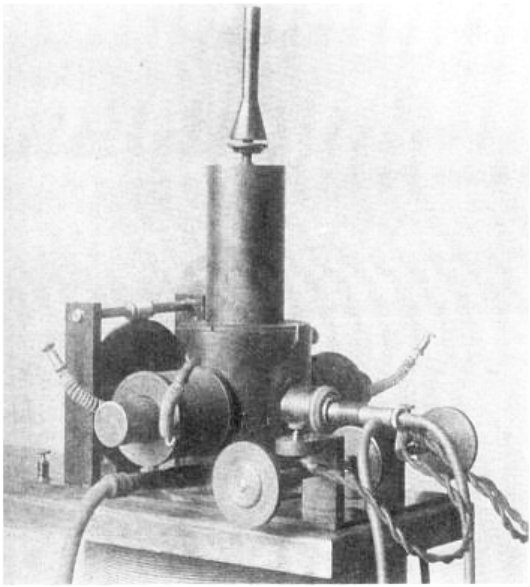Poulsen's first arc converter
Forfatter/Opretter:
Valdemar Poulsen
Kredit:
Retrieved September 22, 2013 from http://www.earlyradiohistory.us/1904pou.htm. Originally published in V. Poulsen, "System for producing continuous electric oscillations" in Transactions of the International Electrical Congress, St. Louis, 1904, Vol. 2, Section C: Electrochemistry, J. B. Lyon Co., 1905, fig.7, facing p. 970 on Google Books
Shortlink:
kilde:
størrelse:
530 x 587 Pixel (43133 Bytes)
beskrivelse:
Prototype arc converter (Poulsen arc) radio transmitter, built by US electrical engineer Valdemar Poulsen in 1903. One of the first continuous wave radio transmitters, it was used in the first AM broadcasting stations until the early 1920s, when it was superseded by vacuum tube transmitters. It consists of a DC electric arc in a chamber filled with either hydrogen or other hydrocarbon gas (center) between the poles of an electromagnet (horizontal cylinders front and back). The anode (right) is water-cooled, the cathode is made of carbon and is rotated continuously (mechanism, rear). The arc is connected to a series resonant circuit (not shown) consisting of a capacitor and inductor, which in turn is connected to a wire antenna. The negative resistance of the arc cancels the positive resistance inherent in the resonant circuit, exciting continuous sinusoidal oscillating currents in the resonant circuit, which are radiated by the antenna as radio waves. The arc oscillator was actually invented by Elihu Thomson in 1892, but the frequency of his device was limited to about 10 kHz. By operating it in a hydrogen atmosphere with a cooled anode, Poulsen was able to raise the frequency into the longwave radio range so it could be used for a radio transmitter.
Licens:
Public domain
Kommentar på licensen:
Poulsen died in 1942, more than 70 years ago
Yderligere oplysninger om licens til billedet kan findes her. Sidste ændring: Sun, 21 Aug 2022 23:37:18 GMT
